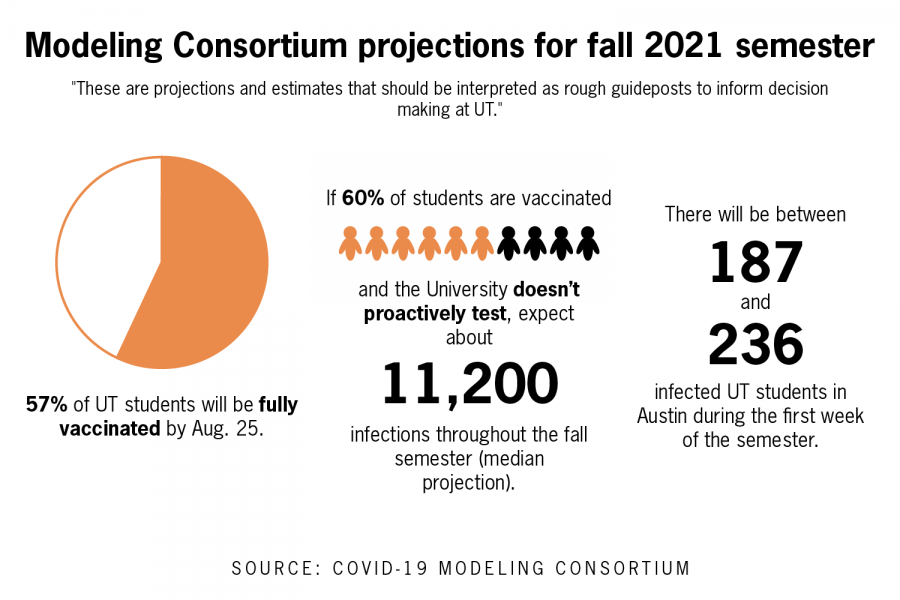COVID-19 could infect thousands of students in fall semester, UT researchers project
August 25, 2021
Editor’s Note: This article first appeared as a part of the August 23 flipbook.
Over 10,000 UT students could potentially contract COVID-19 during the fall semester according to an Aug. 11 report published by the UT COVID-19 Modeling Consortium.
The report conducted by UT researchers estimates that an average of 11,200 students will contract the virus during that time period if the University does not implement proactive testing.
These findings provide the University with projections and awareness of vaccination rates and testing frequencies to help aid in decision-making, said Kaitlyn Johnson, a postdoctoral fellow and lead author of the report.
Johnson said the consortium used available data such as The New York Times’ case counts to estimate the number of students who could contract COVID-19. A similar report from the consortium last fall projected between 82 and 183 students would arrive infected with COVID-19 during the first week of the semester.
The 2021 report estimates that between 187 and 236 students will arrive infected. This year’s higher projections are due to major surges found throughout the United States and Austin, Johnson said.
“What we’re seeing right now is that there’s high levels of disease and infection everywhere in the U.S. and so that’s going to affect the number of infected students arriving at UT because UT is made up of students from the city of Austin, the state of Texas and the rest of the country,” Johnson said.
Amid a surge of COVID-19 cases in Austin, the University is requiring students take a COVID-19 test three days before moving on campus for the beginning of classes. It is also allowing professors to have a limited number of students in class until Sept. 17. Masks and vaccinations are optional.
“Since the start of the pandemic, planning at UT has drawn upon data and analysis from leading epidemiological researchers from the campus community, who have provided projections about the spread of COVID-19 and its implications for UT,” University spokesperson Eliska Padilla said in an email. “These projections have been an important part of the campus planning process since fall of last year.”
The report assumes that 50% of unvaccinated students will participate in proactive testing and isolation if they test positive. If unvaccinated students are tested twice a week under the same vaccination projections, the estimate of students that could contract the virus this fall drops to an average of 1,700, according to the report.
If 80% of students are vaccinated by Aug. 25, symptomatic testing alone should be sufficient to prevent the virus from exceeding “the highest risk threshold,” which is 140 symptomatic cases per 100,000 people in a seven-day period, the report says.
Johnson said the report highlights how increasing the rate of vaccination is the most effective way of reducing the risk of major outbreaks.
“Our projections suggest that proactive testing of unvaccinated students can help to suppress transmission and be cost saving overall, particularly if vaccination levels remain relatively low,” the report said. “However, increasing vaccination coverage among students is likely the most effective means of reducing the burden of COVID-19 and keeping costs low.”
Johnson said students can help prevent the levels of infections the report projects by continuing to wear masks, isolating if they’re sick, practicing social distancing, testing regularly, socializing outdoors and avoiding indoor gatherings.
While masking can also stop the spread of the virus, the University cannot mandate masks due to Gov. Greg Abbott’s executive order in May that bans mask and vaccine mandates in government entities such as school districts, counties and cities. Padilla said the University is on state property, meaning it is a government entity and will “follow all applicable laws and regulations.”
“The University continues to encourage and offer vaccination as the best tool to contain the spread of COVID-19,” Padilla said.



